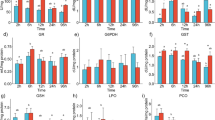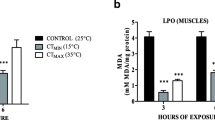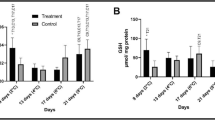Abstract
Climate change may result in future alterations in thermal regime which could markedly affect the early developmental stages of cold water fish due to their expected high sensitivity to increasing temperature. In the present study, the effect of temperature increase of 2, 4 and 6 °C on the oxygen consumption rate (R), the activity of respiratory electron transport system (ETS) and oxidative stress have been studied in four developmental stages of the marble trout (Salmo marmoratus)—eyed eggs, yolk-sac larvae and juveniles of 1 and 3 months. Oxygen consumption rate and ETS activity increased with level of development and with temperature in all four stages. ETS/R ratios decreased during development and correlated with temperature in eyed eggs, larvae and juveniles of 1 month, but not in juveniles of 3 months. Low ETS/R ratios at higher temperatures indicate stress response in eyed eggs, the most temperature sensitive developmental stage. Catalase (CAT) and glutathione reductase (GR) activities increased during development, but responded differently to elevated temperature in the different developmental stages. Stress in eyed eggs, caused by higher temperatures, resulted in increased oxygen consumption rate and increased activities of CAT and GR. Larvae were sensitive to increased temperature only at the highest experimental temperature of 16 °C. Increased temperature did not stress the metabolism of the juveniles, since they were able to compensate their metabolic activity. The earlier developmental stages of marble trout are thus more sensitive to temperature increase than juveniles and therefore more endangered by higher water temperatures. This is the first report connecting oxygen consumption, ETS activity and ETS/R ratio with the activities of antioxidant enzymes in relation to increased temperature in salmonids.


Similar content being viewed by others
References
Abele D, Puntarulo S (2004) Formation of reactive species and induction of antioxidant defence systems in polar and temperate marine invertebrates and fish. Comp Biochem Physiol (A) 138:405–415
Abele D, Heise K, Pörtner HO, Puntarulo S (2002) Temperature-dependence of mitochondrial function and production of reactive oxygen species in the intertidal mud clam Mya arenaria. J Exp Biol 205:1831–1841
Aebi H (1984) Catalase in vitro. Meth Enzymol 105:121–126
Akhtar MS, Pal AK, Sahu NP, Ciji A, Mahanta PC (2013) Thermal tolerance, oxygen consumption and haemato-biochemical variables of Tor putitora juveniles acclimated to five temperatures. Fish Physiol Biochem 39:1387–1398
Angilletta MJ Jr (2009) Thermal sensitivity. In: Angilletta MJ Jr (ed) Thermal adaptation: a theoretical and empirical synthesis. Oxford University Press, New York, pp 35–87
Bagnyukova TV, Chahrak OI, Lushchak VI (2006) Coordinated response of goldfish antioxidant defenses to environmental stress. Aquat Toxicol 78:325–331
Bagnyukova TV, Lushchak OV, Storey KB, Lushchak VI (2007) Oxidative stress and antioxidant defense responses by goldfish tissues to acute change of temperature from 3 to 23 °C. J Therm Biol 32:227–234
Bamstedt U (1980) ETS activity as an estimator of respiratory rate of zooplankton populations. The significance of variations in environmental factors. J Exp Mar Biol Ecol 42:267–283
Barton BA, Schreck CB (1987) Metabolic cost of acute physical stress in juvenile steelhead. Trans Am Fish Soc 116:257–263
Bayir A, Sirkecioglu AN, Bayir M, Haliloglu HI, Kocaman EM, Aras NM (2011) Metabolic responses to prolonged starvation, food restriction, and refeeding in the brown trout, Salmo trutta: oxidative stress and antioxidant defences. Comp Biochem Physiol (B) 159:191–196
Carlberg C, Mannervik B (1985) Glutathione reductase. In: Meister A (ed) Meth enzymology, vol 113. Academic Press, New York, pp 488–495
Davidson JF, Schiestl RH (2001) Mitochondrial respiratory electron carriers are involved in oxidative stress during heat stress in Saccharomyces cerevisiae. Mol Cell Biol 21:8483–8489
Dockray JJ, Reid SD, Wood CM (1996) Effects of elevated summer temperatures and reduced pH on metabolism and growth of juvenile rainbow trout (Oncorhynchus mykiss) on unlimited ration. Can J Fish Aquat Sci 53:2752–2763
Doucet-Beaupré H, Dubé C, Breton S, Pörtner HO, Blier PU (2010) Thermal sensitivity of metabolic enzymes in subarctic and temperate freshwater mussels (Bivalvia: Unionoida). J Therm Biol 35:11–20
Gopalan G, Madon SP, Culver DA, Pappas PW (1996) Measurement of metabolism in free ranging juvenile fishes using the electron transport system (ETS) enzyme assays. In: MacKinlay D, Nelson J (eds) High performance fish II. International congress on the biology of fishes. pp 21–30
Hegazi MM, Attia ZI, Ashour OA (2010) Oxidative stress and antioxidant enzymes in liver and white muscle of Nile tilapia juveniles in chronic ammonia exposure. Aquat Toxicol 99:118–125
Ikeda T (1989) Estimated respiration rate of myctophid fish from the enzyme activity of the electron-transport-system. J Oceanogr 45:167–173
Intergovernmental Panel on Climate Change (IPCC) (2013) Climate change 2013: the physical science basis. In: Stocker TF, Qin D, Plattner G-K, Tignor M, Allen SK, Boschung J, Nauels A, Xia J, Bex V, Midgley PM (eds) Contribution of working group I to the fifth assessment report of the intergovernmental panel on climate change. Cambridge University Press, Cambridge, p 1535
Jeppesen E, Mehner T, Winfield IJ, Kangur K, Sarvala J, Gerdeaux D, Rask M, Malmquist HJ, Holmgren K, Volta P, Romo S, Eckmann R, Sandström A, Blanco S, Kangur A, Stabo HR, Tarvainen M, Ventelä A-M, Søndergaard M, Lauridsen TL, Meerhoff M (2012) Impacts of climate warming on the long-term dynamics of key fish species in 24 European lakes. Hydrobiologia 694:1–39
Kamler E, Keckeis H, Bauer-Nemeschkal E (1998) Temperature-induced changes of survival, development and yolk partitioning in Chondrostoma nasus. J Fish Biol 53:658–682
Kenner RA, Ahmed SI (1975) Measurements of electron transport activities in marine phytoplankton. Mar Biol 33:119–127
Killen SS, Brown JA, Gamperl AK (2008) Lack of metabolic thermal compensation during the early life stages of ocean pout Zoarces americanus (Bloch and Schneider): a benthic, cold-water marine species. J Fish Biol 72:763–772
Lampert W (1984) The measurement of respiration. In: Downing JA, Rigler FH (eds) A manual on methods for the assessment of secondary productivity in fresh water. IPB Handbook 17. Blackwell Scientific Publications, Oxford, pp 413–468
Li X-Y, Huang H-H, Hu K, Liu Y, Jiang W-D, Jiang J, Li S-H, Feng L, Zhou X-Q (2014) The effects of dietary thiamin on oxidative damage and antioxidant defence of juvenile fish. Fish Physiol Biochem 40:673–687
Linton TK, Morgan IJ, Walsh PJ, Wood CM (1998) Chronic exposure of rainbow trout (Oncorhynchus mykiss) to simulated climate warming and sublethal ammonia: a year-long study of their appetite, growth, and metabolism. Can J Fish Aquat Sci 55:576–586
Lukančič S, Žibrat U, Mezek T, Jerebic A, Simčič T, Brancelj A (2010) A new method for early assessment of effects of exposing two non-target crustacean species, Asellus aquaticus and Gammarus fossarum, to pesticides, a laboratory study. Tox Indus Health 26:217–228
Lushchak VI, Bagnyukova TV (2006) Temperature increase results in oxidative stress in goldfish tissues. 2. Antioxidant and associated enzymes. Comp Biochem Physiol (C) 143:36–41
Lyytikäinen T, Jobling M (1998) The effect of temperature fluctuation on oxygen consumption and ammonia excretion of underyearling Lake Inari Arctic charr. J Fish Biol 52:1186–1198
Macy WK III, Durbin AG, Durbin EG (1999) Metabolic rate in relation to temperature and swimming speed, and the cost of filter feeding in Atlantic menhaden, Brevoortia tyrannus. Fish Bull 97:282–293
Martínez-Álvarez RM, Morales AE, Sanz A (2005) Antioxidant defenses in fish: biotic and abiotic factors. Rev Fish Biol Fish 15:75–88
McCarthy ID, Houlihan DF (1997) The effect of temperature on protein metabolism in fish: the possible consequences for wild Atlantic salmon (Salmo salar L.) stocks in Europe as a result of global warming. In: Wood CM, McDonald DG (eds) Global warming: implications for freshwater and marine fish. Cambridge University Press, Cambridge, pp 51–78
McCullough DA, Bartholow JM, Jager HI, Beschta RL, Cheslak EF, Deas ML, Ebersole JL, Foott JS, Johnson SL, Marine KR, Mesa MG, Petersen JH, Souchon Y, Tiffan KF, Wurtsbaugh WA (2009) Research in thermal biology: burning questions for coldwater stream fishes. Rev Fish Sci 17:90–115
Mota M, Sousa R, Araújo J, Braga C, Antunes C (2014) Ecology and conservation of freshwater fish: time to act for a more effective management. Ecol Freshw Fish 23:111–113
Muskó IB, Tóth GL, Szábo E (1995) Respiration and respiratory electron transport system (ETS) activity of two amphipods: Corophium curvispinum G. O. Sars and Gammarus fossarum Koch. Pol Arch Hydrobiol 42:547–558
Myrick CA, Cech JJ Jr (2000) Temperature influences on California rainbow trout physiological performance. Fish Physiol Biochem 22:245–254
Neyfakh AA, Abramova NB (2014) Biochemical embryology of fishes. In: Florkin M, Sheer BT (Eds.), Chemical zoology, deuterostomians, cyclostemes and fishes. pp 275–283. www.books.google.hu/books?isbn=0323163343
Packard TT (1971) The measurement of respiratory electron- transport activity in marine phytoplankton. J Mar Res 29:235–244
Pfeiler E, Govoni JJ (1993) Metabolic rates in early life history stages of elopomorph fishes. Biol Bull 185:277–283
Pörtner HO (2002) Climate variations and the physiological basis of temperature dependent biogeography: systemic to molecular hierarchy of thermal tolerance in animals. Comp Biochem Physiol (A) 132:739–761
Povž M (1995) Status of freshwater fishes in the Adriatic catchment of Slovenia. Biol Conserv 72:171–177
Rocha MJ, Rocha E, Resende AD, Lobo-da-Cunha A (2003) Measurement of peroxisomal enzyme activities in the liver of brown trout (Salmo trutta), using spectrophotometric methods. BMC Biochem 4:2
Roche H, Bogé G (1996) Fish blood parameters as a potential tool for identification of stress caused by environmental factors and chemical intoxication. Mar Environ Res 41:27–43
Rombough PJ (1988) Respiratory gas exchange, aerobic metabolism, and effects of hypoxia during early life. In: Hoar WS, Randall DJ (eds) Fish physiology, The physiology of developing fish; Eggs and larvae, vol 11., part A. Academic Press, London, pp 59–161
Rombough PJ (1997) The effects of temperature on embryonic and larval development. In: Wood CM, McDonald DG (eds) Global warming: Implications for freshwater and marine fish. Cambridge University Press, Cambridge, pp 177–223
Rudneva II (1999) Antioxidant system of Black Sea animals in early development. Comp Biochem Physiol (C) 122:265–271
Simčič T (2005) Respiratory electron transport system (ETS) activity and respiration rate in cold-stenothermal and eurythermal chironomid larvae from high-mountain lakes. Arch Hydrobiol 162:399–415
Simčič T, Brancelj A (1997) Electron transport system (ETS) activity and respiration rate in five Daphnia species at different temperatures. Hydrobiologia 360:117–125
Simčič T, Brancelj A (2007) The effect of light on oxygen consumption in two amphipod crustaceans: the hypogean Niphargus stygius and the epigean Gammarus fossarum. Mar Freshw Behav Physiol 40:141–150
Simčič T, Lukančič S, Brancelj A (2005) Comparative study of electron transport system activity and oxygen consumption of amphipods from caves and surface habitats. Freshw Biol 50:494–501
Simčič T, Pajk F, Vrezec A, Brancelj A (2012) Size scaling of whole-body metabolic activity in the noble crayfish (Astacus astacus) estimated from measurements on a single leg. Freshw Biol 57:39–48
Smith JC, Chong CK (1982) Body weight activities of cytochrome oxidase and electron transport system in the liver of American plaice Hippoglossoides platessoides can these activities serve as indicators of metabolism? Mar Ecol Prog Ser 9:171–179
Stackley KD, Beeson CC, Rahn JJ, Chan SSL (2011) Bioenergetic profiling of zebrafish embryonic development. PLoS ONE 6(9):e25652. doi:10.1371/journal.pone.0025652
Tóth GL (1999) Aktivität des Elektronentransportsystems. In: von Tümpling W, Friedrich G (eds) Biologische Gewässeruntersuchung. Methoden der Biologischen Wasseruntersuchung 2, Gustav Fischer Verl., Jena, Stuttgart, Lübeck, Ulm, pp 465–473
Tóth GL, Szábo M, Webb D (1995) Adaptation of the tetrazolium reduction test for the measurement of the electron transport system (ETS) activity during embryonic development of medaka. J Fish Biol 46:835–844
Vinagre C, Madeira D, Narciso L, Cabral HN, Diniz M (2012) Effect of temperature on oxidative stress in fish: lipid peroxidation and catalase activity in the muscle of juvenile seabass, Dicentrarchus labrax. Ecol Indicat 23:274–279
Vincenzi S, Crivelli AJ, Jesensek D, De Leo GA (2008) Total population density during the first year of life as a major determinant of lifetime body-length trajectory in marble trout. Ecol Freshw Fish 17:515–519
Welker AF, Campos EG, Cardoso LA, Hermes-Lima M (2012) Role of catalase on the hypoxia/reoxygenation stress in the hypoxia-tolerant Nile tilapia. Am J Physiol Regul Integr Comp Physiol 302:R1111–R1118
Acknowledgments
The authors thank Roger Pain for suggestions on an earlier draft of this manuscript and the English revision of the text, and two anonymous reviewers for their constructive comments on the manuscript. The authors acknowledge financial support by the Slovenian Research Agency (Research Programme P1-0255).
Conflict of interest
The authors declare that they have no conflict of interest.
Author information
Authors and Affiliations
Corresponding author
Rights and permissions
About this article
Cite this article
Simčič, T., Jesenšek, D. & Brancelj, A. Effects of increased temperature on metabolic activity and oxidative stress in the first life stages of marble trout (Salmo marmoratus). Fish Physiol Biochem 41, 1005–1014 (2015). https://doi.org/10.1007/s10695-015-0065-6
Received:
Accepted:
Published:
Issue Date:
DOI: https://doi.org/10.1007/s10695-015-0065-6




